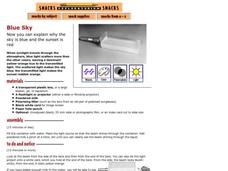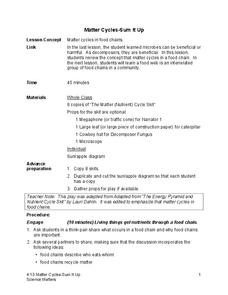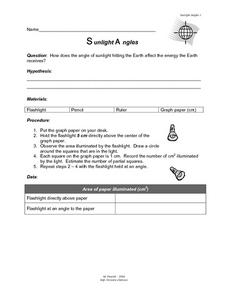Curated OER
SDO Reveals Details on the Surface of the Sun
In this images of the sun worksheet, students read about the images released by NASA's Solar Dynamics Observatory and they solve 3 problems using the given photograph of the sun. Students find the scale of the image, they compare the...
Curated OER
A Bird's Eye Look at the Sun-Earth System
In this Sun-Earth system worksheet, students fill in blanks with the proper terms from a given list to complete a summary of the relationship between the Sun and the Earth. A major topic includes how solar storms effect the Earth and the...
Curated OER
New Angle on Forest Ecology
Students measure and calculate the angle of the sun. They compare the leaf types on the north and south to compare the effects of the sun on the type of vegetation. They complete the activities inside the classroom or on a trip to a...
Curated OER
Seasons Worksheet #3
A diagram outlining the geocentric view of the sun's path across the sky tops this earth science instructional activity. Learners label the zenith and determine the latitude from which this view is taken. It is a compact instructional...
Curated OER
A High-Resolution Satellite Photo
In this high resolution satellite photograph worksheet, students observe a photograph taken by the Lunar Reconnaissance Orbiter of the Tennessee Court House. Students use the photograph to solve 4 problems about the scale of the image,...
Curated OER
The Angle of the Sun's Rays
Students study elevation of the Sun above the horizon and the angle of the rays and their heating power.
Curated OER
Motion of the Sun and Earth: Using a Playground Model to Explore Rotation and Revolution
Learners experience the rotation of the Earth and the Sun and the Earth's revolution around the Sun, using a playground mode.
Curated OER
It's A Meteor
Young scholars complete a webquest to find Earth's relationship to the sun. In this webquest lesson, students complete tasks to understand the effect of the sun on weather and time. Young scholars create a multimedia presentation as an...
Midnight Martian
Moon Globe
Not just a simple globe of the moon, this interactive version allows you to choose lighting according to the location of the sun, views from different positions on Earth, and more! Satellite images and topographic data have been combined...
Curated OER
Taking the Measure of the Universe
Four fabulous activities immerse amateur astronomers into measuring objects that we cannot handle. The experiences are applied to NASA's Space Interferometry Mission, which will take measurements of planets around stars other than our...
Exploratorium
Blue Sky
Use a container full of water as a prism and show that as light is bent, the individual colors from different wavelengths become visible. This explains why the sky appears to be blue midday, and why as the sun nears the horizon, it looks...
Curated OER
Stargazers and Skywatchers
Students observe the daily motions of the sun and relate them to the functions of a sundial. They determine the locations of sunrises and sunsets and determine how the elevation of the sun effects temperature.
Balanced Assessment
Solar Elements
Let your brilliance shine like the sun. Future mathematicians and scientists consider given data on the abundance of different elements in the sun. The assessment task requires consideration of how these different abundances relate to...
Curated OER
Unit VIII: Worksheet 3 - Central Force
Beginning physicists imagine being aerospace engineers by solving seven centripetal force problems. They calculate the work, speed, time, and acceleration of objects in orbit: a satellite around Earth, and Earth around the sun. This is a...
TLS Books
Neptune
Did you know that Neptune is named after the Roman god of the sea? Young astronomers read about this and other facts about the eighth planet from the sun in a short informational text passage.
Science Matters
Matter Cycles — Sum It Up
Scholars become part of the cycle of matter with a reader's theater that showcases producers, consumers, decomposers, and the sun. A diagram and discussion concludes the learning experience and enhances comprehension.
International Technology Education Association
Singin' the Black and Blues
How does the color of the sky change from blue to reds and oranges to black? An illuminating lesson explains how light travels through different mediums using the sun's light as an example. By examining diagrams and illustrations, pupils...
US Department of Energy
Solar Cooking
Who needs a barbecue grill to cook hot dogs when you have the amazing power of the sun at your disposal? Engage young scientists in learning about solar energy with this fun activity that turns a used Pringles can into a solar powered...
Curriculum Corner
Bugs and Flowers Math and Literacy Centers
The sun shines, flowers bloom, and bugs fly—it must be Spring! Add a cheerful theme of bugs and flowers to math and literacy centers. Scholars take part in an assortment of activities designed to reinforce concepts such as identifying...
Stanford University
Louis XIV
His reign was known for the extravagance of Versailles, as well as fiscal failure. Referred to as the Sun King, and the art of Louis XIV's court reflects his absolute power in France. By examining the image of bronze engraving from a...
Curated OER
Astronomy With a Stick
Young scholars find the altitude of the Sun at 10 A.M., at solar noon, and at 2 P.M. by measuring the height of the gnomon and the length of the shadow at each time. They record the measurements in their notebooks for later conversion.
Curated OER
A Lunar Transit of the Sun from Space
In this moon activity, students determine the angular size of the moon and draw a scaled model of the Earth, moon, and sun and given distances and positions. This activity has 4 problems to solve.
Curated OER
Optional Laboratory: Comparing Soil Temperatures In Sun and Shade
Pupils work together to test the temperatures of different soils in shade and sun. They make their own hypothesis before beginning the experiment. They record their data and discuss as a class.
Curated OER
Sunlight Angles
In this sunlight worksheet, students solve the problem of how much energy the Earth receives from the different angles of the sun. Students collect data, chart it, and come up with a conclusion.

























